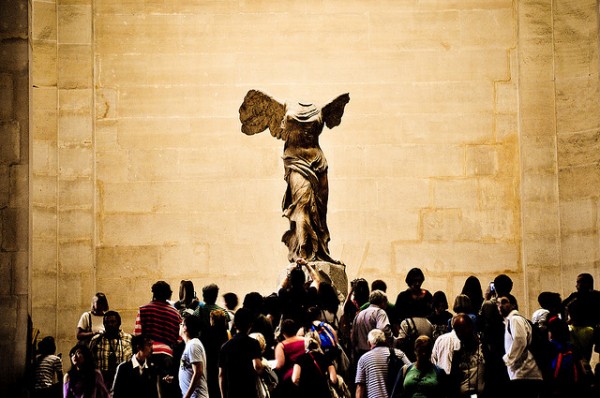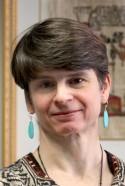
In recent years, museums have come under criticism for many alleged sins–overly aggressive collection practices, questionable finances, elitism, or failure to adapt to the digital world. This has led to a reappraisal by museum leaders and efforts to make museums more accountable and relevant. In advance of a Zócalo lecture by Getty Trust president and CEO James Cuno, we asked several people who think a lot about museums to answer the following question: What should be the purpose of a museum in the information age?
Giving the Public a Voice

If museums had just one purpose, our jobs would be much easier. But museums address multiple needs, regardless of the era in which we find ourselves. For art museums, those needs include collecting and caring for examples of cultural heritage and providing the public with avenues to understanding the intentions of artists in their time and the relevance of works to the present. But the Web has altered this last-mentioned obligation, from dispensing information alone to soliciting new forms of participation. And while museum professionals will always offer the “official” interpretation of objects in our care, we also should welcome the opportunity to attract the notice and to encourage the engagement of people anywhere.
This creates a dilemma: how should museums react to the opinions of the public? Online visitors may advocate changes or new offerings that don’t bear on the museum professionals’ understanding of their job responsibilities. The calibration of the balance between traditional professional duties and new types of engagement will play out one museum at a time, and one director at a time. In my view, there is much value in giving the public a visible voice in adjudicating the success of exhibitions, programs, and other activities, even if the step du jour is as simple as operating a Facebook page or Twitter account for a museum. While providing a forum for such a voice may be disorienting at first, such a strategy can refine the strategies and tactics of art museums for the better.
Maxwell L. Anderson is the Eugene McDermott Director at the Dallas Museum of Art.
————————————-
Public Access, Which Must Come With Public Accountability

In our information age, museums serve the same purpose they always have: providing access to direct encounters with authentic art and artifacts by moving such opportunities out of the salons and palaces and into public venues. New sources of information (and older ones: wall labels, public lectures and dialogues, gallery educators, docents) can encourage, enhance, and expand this encounter, but they cannot replace what the German critic Walter Benjamin famously described as the aura of the authentic. Museums have enriched, even fundamentally shaped, innumerable lives. It seems unlikely that an encounter with a digital T. rex could awe and inspire 5-year-old Stephen Jay Gould like the aura of the real T. rex skeleton at the American Museum of Natural History did. I have collected many personal stories of lives changed by museum experiences, but, Microsoft commercials notwithstanding, I have yet to hear “seeing Monet online made we want to be an artist.”
This capacity of museums makes them extraordinarily powerful and important institutions. Museums are, says philosopher Alain de Botton, “where we might take a group of visiting aliens to show them what we most delight in and revere.” Despite their many virtues–eloquently elaborated most recently by James Cuno–they should not be left unfettered from public scrutiny. Too often, museums have betrayed their purpose, so we must pay close attention to museum matters: who runs them, who chooses their collections, and who determines how the art is displayed. Studying German museums, I witness how often ideologues turn museums to their advantage. While we certainly cannot blame Enlightenment museums for failing to prevent the atrocities of World War II, we should not ignore how Nazi leaders embraced museums and the arts, recognizing their potential to promote ideology. They produced in Degenerate Art what might still be the most successful exhibition of all time. Since the fall of the Berlin Wall, billions of Euros have been spent restoring art museums to precisely their pre-War appearance and content, mostly keeping art from outside Europe separate (in a replica of a Prussian palace in Berlin, no less) from the European collections. No plans are in place to build a museum to the failure of the Enlightenment, though perhaps Daniel Libeskind’s museum architecture in Berlin and Dresden suggests this view.
Here in the U.S. museums have a very different history. Interest in museums has been driven less by extreme ideology than by the need for the one percent to find useful purposes for their increasing share of the national wealth, culminating in the opening of the Waltons’ Crystal Bridges Museum a few months ago. No matter how generous their donors, or how benefactors treat employees while accumulating their fortunes, museums inevitably draw on public funds (through economic development grants, special tax breaks, and so on). The oligarchy of museum governance (how many museum boards are you on?) seems to have frequent conflicts of interest and to routinely exclude certain groups from the galleries. The Guerrilla Girls’ critique–to name one of many–dates from the 1980s and includes a recent open letter to Eli Broad noting that the artists in his publicly supported collections are more than 95 percent white and 83 percent male.
None of this necessarily detracts from the power of the aesthetic encounter. When we enter a museum, a great work of art takes our breath and excites our imaginations. New media can help sate our curiosity, share our inspirations, and even provide greater access to information about museum governance and practice. Available information always should include who chooses the works on display and why the museum considers them worthy of our attention. As museum audiences and supporters, we must conscientiously engage in critical seeing to prevent abuses of the museum’s potential.
Peter Tokofsky organizes public education programs at the J. Paul Getty Museum and is an associate adjunct professor in the Department of Germanic Languages at UCLA.
————————————-
A Place for Serious, Quiet Contemplation

Museums have never mattered more. This is because they hold some of the most important objects from the great civilizations of past. Today, we are enthralled with ourselves, self-centered, expressing what we feel, what we have done, what we want. We have become dislocated from the past and find it hard to imagine how things were any different. The dominance of the Internet, the virtual and the connected in our lives, is clearly wonderful, but we also tend to neglect that which doesn’t change at a click of a mouse.
Museums can be one place where serious, quiet contemplation happens through engagement with the artwork or artifacts, objects that don’t revolve around us. It’s possible to have a transformational experience, engaging with a precious artifact that sheds light on how remote peoples lived, loved, and died. This engagement can transport a spotty teenager from, say, a poor family in London to, say, China in the period of antiquity. That teen will see how she’s connected to other human beings and how her own life could be different. Museums showcase a range of objects–the unique or the representative–and, by doing so, open a door to other times and other worlds.
Dr. Tiffany Jenkins is arts and society director of the Institute of Ideas.
————————————-
Aggregators, Curators, Mentors, and More

In a world shaped by immediate access to a vast sea of digital data, museums will serve as: sources, sharing information emerging from their collecting and research; aggregators, finding and integrating information from the many sources touched by their work; curators, selecting and annotating content to help people find reliable information; and educators, providing context and commentary. Technology will enable museums to scale up these core functions, which are already embedded in their work.
In the future, museums also will become mentors, recruiting and training people to contribute and interpret content; and moderators, encouraging people to engage with content, sharing views, opinions, and their own expertise. And museums will continue to be welcome havens of respite and retreat, where people can unplug, disconnect, and immerse themselves in silence, beauty, and wonder.
Elizabeth Merritt is founding director of the American Association of Museums’ Center for the Future of Museums. CFM is a think-tank and research & development lab that helps museums explore the cultural, political, environmental, economic, and technological trends shaping the future.
————————————-
Conductors of Two-Way Conversations That Surprise

Museums have always been known for the fascinating artifacts in their collections. At the Smithsonian, those include the Star-Spangled Banner, Thomas Jefferson’s writing desk, and the Spirit of St. Louis. There is nothing like seeing the real thing and sharing the experience with others, but today museums have become even more relevant to our society by using the digital tools of the information age.
If you can’t visit us on the National Mall in Washington, D.C., the Smithsonian will come to you. We have 170 affiliate museums all over the country that borrow from our collections and host our traveling exhibits–and 13 of these affiliates are in Southern California. We’re also digitizing our collections and making them available online, so that history, art, science, and culture will be more accessible to everyone, everywhere.
Last year, almost 30 million people visited our museums, but the Smithsonian’s websites counted 79 million unique visitors. Nearly two million people follow us on Twitter and Facebook. But these new technologies are not meant to be one-way streets. In the information age, we’re looking to hear from you. People can interact with our researchers and experts through our blogs and mobile apps, comment on our exhibits, and provide us with information. We want the Smithsonian to be a conversation, not a lecture.
A few years ago, I spoke with a young woman in San Francisco about what she wanted from the Smithsonian. She said, “Surprise me.” Every time we reach out to our visitors, we try to live up to that challenge and not only surprise, but delight, educate, and engage. Now, with the tools of social media and mobile technology, all museums can be more dynamic engines of learning.
Wayne Clough is the 12th Secretary of the Smithsonian Institution.
*Photo courtesy of alex4981.



